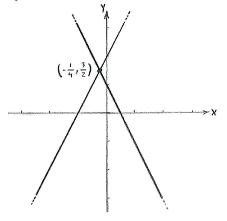Lösung 2.2:6e
Aus Online Mathematik Brückenkurs 1
(Unterschied zwischen Versionen)
K (hat „Solution 2.2:6e“ nach „Lösung 2.2:6e“ verschoben: Robot: moved page) |
|||
| Zeile 1: | Zeile 1: | ||
| - | + | Der Schnittpunkt der Geraden muss die Gleichungen beider Geraden erfüllen | |
{{Abgesetzte Formel||<math>2x+y-1=0\qquad\text{and}\qquad y-2x-2=0\,\textrm{.}</math>}} | {{Abgesetzte Formel||<math>2x+y-1=0\qquad\text{and}\qquad y-2x-2=0\,\textrm{.}</math>}} | ||
| - | + | Wenn wir von der ersten Gleichung <math>y</math> mit <math>2x+2</math> ersetzen, bekommen wir eine Gleichung mit nur <math>x</math> | |
{{Abgesetzte Formel||<math>2x+(2x+2)-1=0\quad\Leftrightarrow\quad 4x+1=0\,,</math>}} | {{Abgesetzte Formel||<math>2x+(2x+2)-1=0\quad\Leftrightarrow\quad 4x+1=0\,,</math>}} | ||
| - | + | Wir erhalten <math>x=-1/4\,</math>, und die erste Gleichung, <math>y=2x+2</math>, gibt uns <math>y = 2\cdot(-1/4)+2 = 3/2\,</math>. | |
| - | + | Also ist der Schnittpunkt <math>\bigl(-\tfrac{1}{4},\tfrac{3}{2}\bigr)</math>. | |
| - | <math>\bigl(-\tfrac{1}{4},\tfrac{3}{2}\bigr)</math>. | + | |
<center>[[Image:2_2_6_e.gif|center]]</center> | <center>[[Image:2_2_6_e.gif|center]]</center> | ||
| + | Wir kontrollieren zur Sicherheit dass der Punkt <math>\bigl(-\tfrac{1}{4},\tfrac{3}{2}\bigr)</math> auch wirklich beide Gleichungen erfüllt | ||
| - | + | :*2''x'' + ''y'' - 1 = 0: <math>\quad\textrm{Linke Seite} = 2\cdot\bigl(-\tfrac{1}{4}\bigr) + \tfrac{3}{2} - 1 = -\tfrac{1}{2} + \tfrac{3}{2} - \tfrac{2}{2} = 0 = \textrm{Rechte Seite.}</math> | |
| - | + | ||
| - | + | :*''y'' - 2''x'' - 2 = 0: <math>\quad\textrm{Linke Seite} = \tfrac{3}{2}-2\cdot\bigl(-\tfrac{1}{4}\bigr)-2 = \tfrac{3}{2} + \tfrac{1}{2} - \tfrac{4}{2} = 0 = \textrm{Rechte Seite.}</math> | |
| - | + | ||
| - | :*''y'' - 2''x'' - 2 = 0: <math>\quad\textrm{ | + | |
Version vom 12:02, 13. Mär. 2009
Der Schnittpunkt der Geraden muss die Gleichungen beider Geraden erfüllen
| \displaystyle 2x+y-1=0\qquad\text{and}\qquad y-2x-2=0\,\textrm{.} |
Wenn wir von der ersten Gleichung \displaystyle y mit \displaystyle 2x+2 ersetzen, bekommen wir eine Gleichung mit nur \displaystyle x
| \displaystyle 2x+(2x+2)-1=0\quad\Leftrightarrow\quad 4x+1=0\,, |
Wir erhalten \displaystyle x=-1/4\,, und die erste Gleichung, \displaystyle y=2x+2, gibt uns \displaystyle y = 2\cdot(-1/4)+2 = 3/2\,.
Also ist der Schnittpunkt \displaystyle \bigl(-\tfrac{1}{4},\tfrac{3}{2}\bigr).
Wir kontrollieren zur Sicherheit dass der Punkt \displaystyle \bigl(-\tfrac{1}{4},\tfrac{3}{2}\bigr) auch wirklich beide Gleichungen erfüllt
- 2x + y - 1 = 0: \displaystyle \quad\textrm{Linke Seite} = 2\cdot\bigl(-\tfrac{1}{4}\bigr) + \tfrac{3}{2} - 1 = -\tfrac{1}{2} + \tfrac{3}{2} - \tfrac{2}{2} = 0 = \textrm{Rechte Seite.}
- y - 2x - 2 = 0: \displaystyle \quad\textrm{Linke Seite} = \tfrac{3}{2}-2\cdot\bigl(-\tfrac{1}{4}\bigr)-2 = \tfrac{3}{2} + \tfrac{1}{2} - \tfrac{4}{2} = 0 = \textrm{Rechte Seite.}

